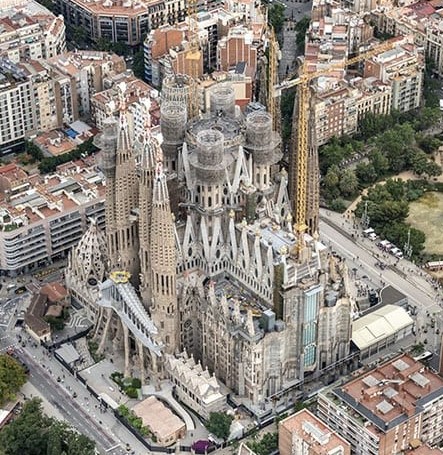This week, I am again delighted to present another guest “speaker,” Candida Kirkpatrick. Below is an adapted version of the talk she wrote on the “sacramentality of marriage” during our recent TOB Speaker Training.
PLEASE NOTE: TOB TUESDAYS WILL BE TAKING A BREAK UNTIL SEPTEMBER. At that time, we will relaunch with a new format in honor the 40th anniversary of the beginning of St. John Paul II’s TOB Wednesday audiences. I pray you have a joyful and refreshing summer. See you in September!
******
“Rome wasn’t built in a day.” How true this 12th century French proverb rings for all of us who have experienced the often long and laborious process of building anything of value – whether it be a home for our families, a business, or marriage itself. We see that God also tends to reveal and establish His reign in our hearts, homes, and even society over the ages, brick by brick, step by step. To see this at work, we only need to look at salvation history, which teems with the gradual unfolding of God’s spousal relationship with mankind as the crown of his creation.
In his captivating book, Jesus the Bridegroom: The Greatest Love Story Ever Told, Dr. Brandt Pitre tells us that “God does not give up on his bride, but promises to one day forgive her sins by establishing a new marriage covenant with her” (p. 17).
The spiritual wedding between God and Israel began with the Exodus from Egypt, when the Jewish people were delivered out of slavery and into an intimate relationship with Yahweh. This marital covenant was sealed at Mt. Sinai with the gifting of the Ten Commandments accompanied by a spiritual banquet, which ends in a heavenly feast during which “they beheld God, and they ate and they drank” the covenant meal (Ex 24:11).
The Prophet Jeremiah further expressed this spousal sentiment of God for His people when he proclaimed: “I remember the devotion of your youth, your love as a bride, how you followed me in the wilderness, in a land not sown” (Jer 2:1-2).
Thus, began a series of breaking and re-establishing the covenant, with countless infidelities on Israel’s part and innumerable expressions of forgiveness on the part of God’s steadfast love, compassion, and faithfulness. And so, the cycle continued until the cosmic event of Jesus Christ’s Incarnation and birth. The Catechism of the Catholic Church #522 tells us, “The coming of God’s Son to earth is such an event of such immensity that God willed to prepare it for over centuries. He made everything converge on Christ: all the rituals and sacrifices, figures and symbols of the First Covenant.”
We see the spousal love of God for His people carried out to its fullness through Christ’s Passion and Death. St. Paul states in Eph 5:25, “Christ loved the Church and gave himself for her”. To such depths was Christ’s love for His bride that, at the moment of His death on the Cross, “one of the soldiers pierced His side with a spear, and at once there came out blood and water” (Jn. 19:34). St. Augustine comments that, “Just as Eve came from the side of the sleeping Adam, so the Church was born from the side of the suffering Chris.” (St. Augustine, Ps 138:2). This birthing of the Church-Bride from His side was the fruit of Jesus’ divine spousal love. St. John Paul II echoes St. Augustine in his Theology of the Body Audience 90:5 when he says, “Through a total gift that springs from love, he [Christ] formed the Church as his body and continually builds her…” – right up to today through the Eucharist.
Whew! I think it is safe to affirm that Rome wasn’t built in a day, nor the Church or our marriages or any other component of God’s Kingdom. Instead, we see throughout human history this gradual revelation of God’s spousal love, and the Holy Spirit drawing our marriages and individual souls brick by brick and step by step into this Great Spousal Mystery. In fact, it strikes me that this unfolding of spousal intimacy with God is architecturally depicted in the amazing Minor Basilica of the La Sagrada Familia (The Holy Family) in Barcelona, Spain.
Construction on the church of the Sagrada Familia began in 1882 and continues to this very day, 137 years later. Talk about a gradual construction into something beautiful and sacred! This stunning structure has survived the death of its primary designer, an attack on the crypt, and many architectural blueprints and models that were burned during the Spanish Civil War as well as intense pressure to scrap the whole thing and tear it down! (Do you ever feel as if your marriage has gone through similar stages? I sometimes do!)
This famous neo-Gothic church was designed mostly by well-known architect Antoni Gaudi, known as “God’s architect.” Gaudi recognized the sacramental reality of nature and its ability to reveal God as Creator. He also saw God’s nuptial love interwoven throughout family, creation, and the Sacraments of the Church and wanted to communicate this nuptial reality in a tangible way to all who visited this magnificent church.
To do this, Gaudi designed Sagrada Familia as an icon of Spousal Love, represented in an abundance of symbols depicting salvation history: its porticos consist of the three virtues of Faith, Hope, and Love and each of its three façades is dedicated to a particular component of the Paschal Mystery: Christ’s Nativity, His Passion, and His Resurrection. The largest of these is the Glory façade, still under construction. It consists of death, final judgment, and heaven, and is scheduled to be completed by the year 2026, the 100th anniversary of Gaudi’s death. Generosity, patience, and a special kind of sacramental vision seem to fill the entire ambiance of this great cathedral.
The first time I visited Sagrada Familia in 1991, it had no roof. I felt as if I were entering an open-air museum saturated with a Dr. Seuss kind of style: vast symbols of nature covered every nook and cranny of the interior space while the beauty of the exterior Nativity Façade provided a dramatic theme of Christ’s Birth and the Holy Family’s journeys to and from Bethlehem. I remember thinking it was the most unusual church I had ever visited, and I couldn’t quite imagine the final product.
Fortunately, my knowledgeable roommate (an architect major) helped me understand Gaudi’s love for symbolism and its application to the Church. Gaudi used shells, snails, bugs and butterflies, frogs and turtles, flora and fauna to depict the meaning of Church and to plumb the depths of God’s transcendence and mystery. In a word, he recognized what St. John Paul II describes as a small ‘s’ sacrament: Gaudi explored “the very mystery of God, which is hidden from eternity, yet not in an eternal concealment, but first in its very revelation and realization” (TOB A98:8). Gaudi passionately dedicated himself to representing the revelation and realization of this Great Mystery through the symbols of creation.
For example, Gaudi placed the shells of turtles on the bottom of pillars to depict the indissolubility of the Church and even marriage itself. Jesus tells Peter in Mt. 16:18: “You are Peter, and upon this rock I will build my church, and the gates of hell shall not prevail against it.” This rock upon, which the Church is built, mirrors the vows of the Sacrament of marriage, “to be faithful to you always, in joy and in sorrow, in sickness and in health, and to love you and honor you all the days of my life ‘til death do us part.” This profound vow of indissolubility is built upon the rock, the pillar, of Christ’s unwavering fidelity.
Once the marriage vows are professed and the conjugal bond is sealed in the one-flesh union, the human covenant of marriage participates in Christ’s spousal covenant with his Bride, the Church. The Catechism of the Catholic Church articulates this marital “architecture” beautifully when it says: “The covenant between spouses is integrated into God’s covenant with man. Authentic married love is caught up into divine love…. Matrimony signifies the union of Christ and the Church. It gives spouses the grace to love each other with the love with which Christ has loved his Church” (CCC 1639, 1661).
This sacramental reality of marriage as a real representation of Christ’s spousal love for the Church is represented throughout the entirety of Sagrada Familia. St. Joseph as head of the Holy Family is movingly depicted as giving up everything for his new bride Mary; he leaves everything behind to protect both his spouse and the Christ Child who was entrusted to him. The Blessed Virgin Mary is also highly honored throughout the sanctuary and exterior façades. In her pure, virginal receptivity, she is rendered as receiving the protection of St. Joseph as a gift. She places herself under his leadership and mission of keeping the family together and safe. In other words, Mary was “sub-missive” to Joseph as her husband: she willingly placed herself under the mission God had entrusted to Joseph by trusting his discernment.
Despite eminent threats and dangers to their own lives and the life of the Son of God, Joseph and Mary mutually submitted themselves to one another “out of reverence for Christ” (see Eph 5:21) and fulfilled the mission entrusted to them as a couple. They guarded one another and kept their beloved Christ Child secure. Undoubtedly, their marriage was centered on Christ as the foundation of life and the gift of salvation in their very midst!
For us, it can sometimes be challenging to keep Christ in the center of our marriage, to be mutually submissive to one another and to integrate His invitation of spousal love into every area of our lives. Sometimes our individual stories and marriage journeys have more in common with the people of the Old Testament than we care to admit. We promise fidelity to God, and then we wander off into the darkness or erect a golden idol for ourselves. We seek to live out our wedding vows through a total gift of self, and then find ourselves holding back, blocking our receptivity to our spouse through the need to control, wear false masks, rationing our time and attention, or other types of infidelities big and small. At times, we may even discover a crack in our foundation with God and our spouse due to neglect – or even a big gaping hole due to sin.
In times like these, in times of sorrow and disillusionment, Christ invites us again into the security of relationship with Him as He beckons us to surrender to His spousal love. Christ reassures us: “I will abide in Thy tent to eternities, I will trust in the covert of Thy wings” (Ps. 61:4). He enlarges our hearts, our understanding of love, and our relationships with God and with others: “Enlarge the place of thy tent, and let them stretch forth the curtains of thine habitations (Isaiah 54:2).” Marriage in Christ, St. John Paul II reminds us, is not only spousal, but redemptive. We experience the joys of creation and resurrection, but also the trials and perseverance of the Paschal Mystery. Like Sagrada Familia, Divine Love is working to construct the roof of our domestic church, to help every marriage “become a holy temple in the Lord…. [For] in him you too are being built together to become a dwelling in which God lives by his Spirit” (Eph 2:19-22).
As a holy temple, a domestic Church, marriage and family life find their source and summit in the Eucharistic celebration of Holy Mass. The Eucharistic liturgy is our wedding feast with the Divine Bridegroom. The Catechism strikingly declares: “The nuptial covenant between God and his people Israel had prepared the way for the everlasting covenant in which the Son of God, by becoming incarnate and giving his life, has united to himself in a certain way all mankind saved by him, thus preparing for the ‘wedding feast of the Lamb’” (CCC #1612).
By participating as a couple (and family) in receiving the body and blood, soul and divinity of Jesus Christ the Divine Bridegroom, we receive sustenance for the journey of marriage and participate in a unique way in Christ’s spousal love for the Church. In this Holy Communion between ourselves and Christ, St. JPII tells us, “We find ourselves at the very heart of the Paschal Mystery, which completely reveals the spousal love of God. Christ is the Bridegroom because, ‘he has given himself’: his body has been ‘given,’ his blood has been ‘poured out’ {Lk 22:19-20] …. The Eucharist is the Sacrament of our Redemption. It is the Sacrament of the Bridegroom and the Bride” (Mulieris Dignitatem no. 26). When we hear this, we hopefully cry out in profound thanksgiving, joy, and adoration, “Blessed are those who are invited to the marriage supper of the Lamb!” (Rev 19:9).
After more than 100 years, the sanctuary of Sagrada Familia was finally consecrated in 2010 by Pope Benedict XVI. In his homily, he beautifully reminded the world of the mission of marriage as revealed and sustained by Jesus Christ: “The Lord Jesus is the stone which supports the weight of the world, which maintains the cohesion of the Church and brings together in ultimate unity all the achievements of mankind…The home formed by Jesus, Mary and Joseph has always been regarded as a school of love, prayer and work. The promoters of this church wanted to set before the world love, work and service lived in the presence of God, as the Holy Family lived them.” We must remember that we are each God’s temple, and we are “as living stones being built up, a spiritual house, a holy priesthood, to offer up spiritual sacrifices, acceptable to God by Jesus Christ” (1 Pet 2:5).
As married couples live out spousal love in marriage with “determined determination,” encountering the joys and sorrow of Christ’s passion and resurrection. They learn together how to build and rebuild, fortify and fill in, stretch and grow, strengthen and seek to create beauty. They themselves become an icon of the Sagrada Familia and of Christ’s spousal love for the Church. They show the world Christ’s love for His bride, the Church, and how, like Rome, it wasn’t built in a day, or even a couple centuries, but is being built throughout the course of history.
Upon visiting Sagrada Familia again in 2015, I was stunned by the progress that had been made since my last visit some 25 years prior. The roof was completed, and two of the three exterior edifices were also finished. The altar stood at the center of the basilica and the stained-glass windows glimmered with vibrant shades, symbolizing the various mysteries of the Rosary and our faith. I marveled at the progress made with the passage of time, and was reminded that we, too, must trust that Jesus and the Father “are at work even now” (Jn 5:17) – in our marriages, families, and the Church even (and especially!) when progress seems slow or even non-existent. Encountering such beauty in the spousal love expressed between God and humanity, within marriage and in all of creation, should give us great hope during the construction and reconstruction phases of our lives as we recognize that God “has made everything beautiful in its time” (Ecc 3:11).
© Candida Kirkpatrick




